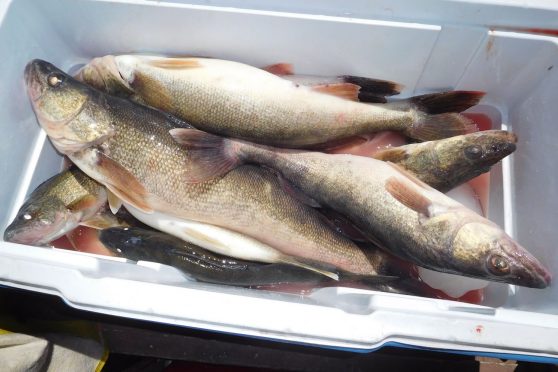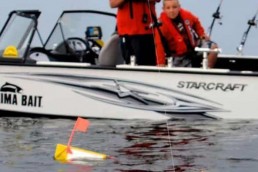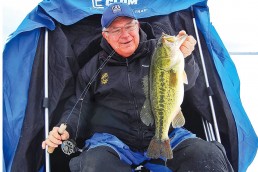All Aboard with Little Boards and Other Presentations
SHARE THIS POST
Too often, small boat owners believe they are confined to flat-line trolling when thinking about walleyes. They believe big planer boards only work on large boats. This statement is a truism that I can personally vouch for. One time I tried to troll a Prince Mastercraft full-sized planer board from a 14-foot boat powered by a 15-horsepower motor. Yeah, I did it, but my motor was cocked at a 45-degree angle in an attempt to counteract the big board’s pull.
Since that episode, smaller planer boards, less than a foot, came along. The quality ones are very effective and can turn a smaller boat into a Lake Erie fish-catching machine. For those who never tried them, do yourself a favor and buy a couple for starters. However, get those that are weighted so they don’t tip over in the waves. While I use Off Shore mini-boards, other brands also are effective.
 Basics to remember about boards
Basics to remember about boards
Let’s discuss a few basics about the mini-boards. First, put the boards’ flags up before fishing. This makes it much easier for the boat passengers to keep track of the boards. Also, nearby crafts can see them, thus avoiding your lines.
Next, there are two basic types of release clips that attach the fishing line to the board. The regular clip has two rubber pads inside the clip’s end, with a small plastic pin in the middle of the pad. The angler squeezes down on the clip to slide the line in. Make certain to place the line on the back of the pin. If not, the line may pull free of the clip, causing the board to break free and float away.
This is not good, because the free-floating board lays flat. This makes it very difficult to find, especially on a choppy lake. With an indelible marker, I put my name and cellphone number on the back of the board. Believe it or not, one day I lost a board. Later, while still on the lake, I received a call and got my board back.
Those who want a release clip that grips extra hard should consider one with small plastic lever that snaps down. These are especially effective at preventing super lines from sliding when under heavy stress. Yes, they are a bit pricey, but cheaper than a new board.
Now, the standard clip’s pressure on the line can be adjusted. Inside the clip is a spring. To get a tight grip, slide the spring towards the line-holding rubber pads. However, this also makes it harder for your fingers to open the clip. To lessen the clip’s tension, take a small screwdriver and slide the spring back towards the board.
However, the lighter pressure can cause the clipped line to move. To prevent the sliding line, wrap the line once around the end of the clip before securing it inside the clip. Yes, it takes more time to free when a fish is on, but it is possible. When a fish is hooked, keep the boat moving so the other lines don’t get tangled. It also keeps tension on the hooked fish.
The beauty of the boards is that they allow the small-boat owner to cover a large swath of water. It also lets the angler fish a number of different baits, colors and depths at the same time. In my smaller boat, I have fished six boards at a time. I also had steelhead hit an outside board. For those who have never hooked a lake-run steelhead, it’s a sight to behold and fear when fishing several boards.
Keeping it all clear
Multiple jumps, pirouettes—along with sizzling dashes across the other lines—can knit all the lines into tangled ball of consternation. It is a nightmare trying to free all the crossed lines.
Are you enjoying this post?
You can be among the first to get the latest info on where to go, what to use and how to use it!
So, for the beginner, a pair of boards is a good start. Let them out about 50 to 75 feet from the boat. After running the boards out, ready a second pair of longer rods, eight foot or more. Either fish these lures by flat-line trolling or with Dipsy Divers at a three setting. The longer rod gets the lure farther from the boat. These board-less rods can be brought in quickly when a fish is on a planer.
When ready for multiple boards, here’s a few suggestions. Run a deep-diving plug, like a Reef Runner on the outside boards. Have a depth chart for the lures to determine how much line (leads) should be let out to get the plug to the desired depth. Then, clip on the board. Your locator should tell you what level the fish are residing.
Run the lures above the fish. Don’t be afraid to troll one lure 10 feet from the surface. Consistent Lake Erie lure colors have pink, purple, or chartreuse on them. If these don’t produce, don’t be afraid to try other lures or colors. Reef Runners, Perfect 10’s and Bandits are favorite Lake Erie lures in the summer. Keep changing your presentations until the right combinations work. Erie walleyes can be finicky and unpredictable.
When experimenting with different colors or lure types, run them on the inside boards. These are easier to check because they don’t cross another board’s line. If there is a fish on the outside board, pull in the inside lines first to avoid a line tangle.
This also is why worm harnesses are best run on inside lines. Walleyes love night crawlers and painted copper/brass spinners. So do white bass, sheepshead, perch, etc. These less-desirable fish, can strip a crawler from a spinner. The theft might not be detected on the board. I have two friends whose inside rods have FireLine on their reels. They hold the rod and can feel the light-hitting bait snatchers. And these lines have boards on them.
Check early, check often
When fishing crawlers, if there is any sign of a bite—even a light one—check it. If after 20 minutes no hits are felt on the spinner/crawler, check it. Some of the bait stealers are pickpockets and their theft goes unnoticed. Also, this year, due diligence is especially critical with the large number of smaller walleyes from the 2015 hatch.
How do you know there is a hit on the boards? Normally, the mini-board starts sliding behind the boat. No hurry to grab the rod, as long as you keep the boat moving. The trolled lure will set the hooks. At times, the board may act a tad differently, but it doesn’t start moving back around. We have had some big walleyes suck in the lure and literally swim with the bait for a number of minutes. So, when the board acts even a tad strange, check it. Oh yes, there are times when a monster sinks the board out of sight. When this happens, it’s all hands on deck.
It’s not a bad idea to have a few glow sticks (cyalume) on board. Kids use these light sticks for trick or treating at Halloween. They can be bought for a dollar at the Dollar Stores. If the fish are biting in the evening and it’s getting dark, put a glow stick on the top of the board and hold it in place with two rubber bands or zip ties. Yellow is the easiest color to see. In the dark, it is neat to see the glowing board swinging behind the boat, with a big walleye at the end of its line.
There is another method that can be fished without tangling the board lines. Run a bait straight back of the boat. When the lure is at the desired depth, clip on a large, round bobber the size of a pool ball. A cheap red and white clip-on-bobber will work. Let line out until the bobber is 100 feet or more behind the boat. Now, the bait is far enough away so it won’t tangle with the lures on the boards. Also, the boat is long gone from the fish and the motor doesn’t spook them.
Finally, let’s be safe out there. Smaller boats shouldn’t put themselves into situations where they are fighting storms and large waves. Keep a sharp eye on the weather and your smartphone. No need to go miles offshore. Fish the near-shore rock piles and humps. Often, they hold smallmouths and walleyes who are quite willing to hit your trolled lures
MWO
SHARE THIS POST
Did you enjoy this post?
You can be among the first to get the latest info on where to go, what to use and how to use it!
Paul Liikala
Paul Liikala was raised on a farm which was close to Lake Erie and the Grand River. He was fortunate to have parents who nurtured his love for the outdoors. His only hope is that his writings show the love and admiration that he has for the Great Outdoors and its participants.



